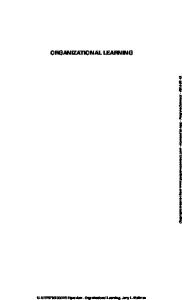How to enhance radical innovation? The importance of organizational design and generative learning
- PDF / 866,656 Bytes
- 22 Pages / 439.37 x 666.142 pts Page_size
- 43 Downloads / 336 Views
How to enhance radical innovation? The importance of organizational design and generative learning Emilio Domínguez Escrig1 · Francisco Fermín Mallén Broch1 · Rafael Lapiedra Alcamí1 · Ricardo Chiva Gómez1 Received: 15 June 2018 / Accepted: 3 January 2019 © Springer-Verlag GmbH Germany, part of Springer Nature 2019
Abstract While previous studies have tried to disentangle how the structure of an organization influences its capability to innovate, the results obtained to date are inconclusive and often contradictory. As a result, it is difficult to generalize the conclusions of previous research. In this regard, some authors have pointed out that it is necessary to consider mediating variables to explain how the structure of the organization or some of its characteristics affect innovation. Since the effects of an organic structure must be investigated in conjunction with firm-specific capabilities, such as those related to organizational learning processes, this study considered the role of generative learning as an explanatory variable. Generative learning has the potential to question the current norms of the organization, going beyond simple improvements, in a process that involves intuition, attention, dialogue and inquiry. Using a sample of 251 companies, this study provides empirical evidence of the mediating role of generative learning in the relationship between organic structure and radical innovation. Keywords Organic structure · Organizational design · Generative learning · Radical innovation Mathematics Subject Classification 90B70
* Emilio Domínguez Escrig [email protected] Francisco Fermín Mallén Broch [email protected] Rafael Lapiedra Alcamí [email protected] Ricardo Chiva Gómez [email protected] 1
Departamento de Administración de Empresas y Marketing, Universitat Jaume I, Av. SosBaynat s/n, 12071 Castellón de la Plana, Spain
13
Vol.:(0123456789)
E. Domínguez Escrig et al.
1 Introduction The world today is experiencing major social, economic and technological changes. An industrial society, based on production, is in the process of becoming a post-industrial society, focused on knowledge. All this affects companies and organizations, which have to work in a constantly changing, increasingly unpredictable and difficult environment. In this context, companies must innovate to face growing competition and ensure their long-term survival. This uncertain scenario is changing the classical way organizations work and is forcing them to reconsider their traditional leadership styles, labor relations or human resources policies, thereby transforming their structures. Organizational structure is a key element to generate innovations, and certain types of structure may facilitate or hamper it. The most extended idea is that mechanistic structures hinder innovation, while organic structures promote it. However, a significant number of empirical studies obtained conflicting results (e.g., Cosh et al. 2012; Song and Chen 2014). Accordingly, Cabello-Medina et al. (2011) stated that the idea that organization
Data Loading...











